- Home
- Larry McMurtry
Custer
Custer Read online
Thank you for purchasing this Simon & Schuster eBook.
* * *
Join our mailing list and get updates on new releases, deals, bonus content and other great books from Simon & Schuster.
CLICK HERE TO SIGN UP
or visit us online to sign up at
eBookNews.SimonandSchuster.com
Contents
Chapter 1
Chapter 2
Chapter 3
Chapter 4
Chapter 5
Chapter 6
Chapter 7
Chapter 8
Chapter 9
Chapter 10
Chapter 11
Chapter 12
Chapter 13
Chapter 14
Chapter 15
Chapter 16
Chapter 17
Chapter 18
Chapter 19
Chapter 20
Chapter 21
Chapter 22
Chapter 23
Chapter 24
Chapter 25
Chapter 26
Chapter 27
Chapter 28
Chapter 29
Chapter 30
Chapter 31
Chapter 32
Chapter 33
Chapter 34
Chapter 35
About Larry McMurtry
Illustration Credits
Bibliography
For Barbara Harris,
beloved helpmate
AT ONE TIME A PICTURE called Custer’s Last Stand hung in virtually every saloon in the land, and quite a few barbershops too. I first saw it in our small barbershop, in Archer City, Texas. A painting by Cassilly Adams, lithographed by Otto Becker, was given away by the thousands by Anheuser-Busch, the great brewing enterprise of St. Louis: General George Armstrong Custer, long locks flying, was fighting on staunchly against terrible—in fact impossible—odds. And when he fell, along with some 250 of his men, the world was no longer the same.
Buffalo Bill Cody often used a skit called “Custer’s Last Rally,” as the finale of his Wild West Show, bringing the notion of long flowing locks and also the notion of a last stand to much of the civilized world. Adams’s painting and Becker’s lithograph are among the most famous images to come out of America. They brought the tragedy of the Little Bighorn alive to people not yet born.
George Armstrong Custer usually wore his hair long, but on the day of the famous battle—June 25, 1876—he sported a fresh haircut. The Indian who killed him—there are several candidates—may not immediately have known who they killed. But the women of the Sioux and Cheyenne, who soon came along and pierced Custer’s eardrums with awls because he had disobeyed a perfectly clear warning from the Cheyenne chief Rock Forehead to respect the peace pipe, which Custer had smoked with him, knew exactly who they were working on. They were working on Long Hair, whose hair just didn’t happen to be long on the day he met his death.
BY 1876, THE YEAR THE Battle of the Little Bighorn was fought, the United States had become a nation of some forty million people, the vast majority of whom had never seen a fighting Indian—not, that is, unless they happened to glimpse one or another of the powerful Indian leaders whom the government periodically paraded through Washington or New York, usually Red Cloud, the powerful Sioux diplomat, who made a long-winded speech at Cooper Union in 1870. Or, it might be Spotted Tail, of the Brulé Sioux; or American Horse, or even, if they were lucky, Sitting Bull, who hated whites, the main exceptions being Annie Oakley, his “Little Sure Shot,” or Buffalo Bill Cody, who once described Sitting Bull as “peevish,” surely the understatement of the century. Sitting Bull often tried to marry Annie Oakley, who was married; he did not succeed.
The main purpose of this parading of Native American leaders—better not call them chiefs, not a title the red man accepted, or cared to use in their tribal life—was to overwhelm the Indians with their tall buildings, large cannon, and teeming masses, so they would realize the futility of further resistance. The Indians saw the point with perfect clarity, but continued to resist anyway. They were fighting for their culture, which was all they had.
One white who recognized this was the young cavalry officer George Armstrong Custer himself, who, in his flamboyant autobiography, My Life on the Plains, makes this point:
If I were an Indian I think that I would greatly prefer to cast my lot with those of my people who adhered to the free life of the plains rather than to the limits of a reservation, there to be the recipient of the blessed benefits of civilization, with the vices thrown in without stint or measure.
Captain Frederick Benteen, who hated Custer and made no secret of it, called Custer’s book My Lie on the Plains. Yet the book, despite its inaccuracies, is still readable today.
Ulysses S. Grant, who didn’t like Custer either, had this to say about the dreadful loss of life at the Little Bighorn:
I regard Custer’s massacre as a sacrifice of troops, brought on by Custer himself, that was wholly unnecessary. . . . He was not to have made the attack before effecting the juncture with Generals Terry and Gibbon. Custer had been notified to meet them, but instead of marching slowly, as his orders required, in order to effect that juncture on the 26th, he entered upon a forced march of eighty-three miles in twenty-four hours, and thus had to meet the Indians alone.
That comment made Custer’s widow, Libbie Custer, an enemy of Grant for life.
Thinking back on a number of important issues, Red Cloud of the Oglala Sioux made this comment: “The Whites made us many promises, more than I can remember,” he said. “But they only kept one. They said they would take our land and they took it.”
RED CLOUD ADDRESSING A NEW YORK AUDIENCE.
Crazy Horse, now thought by many to be the greatest Sioux warrior, refused to go to Washington. He didn’t need to see tall buildings, big cannon, or teeming masses to know that his people’s situation was dire. After the victory at the Little Bighorn the smart Indians all knew that they were playing an endgame. The white leaders—Crook, Miles, Terry, Mackenzie—especially Mackenzie—were even so impolite as to fight in the dead of winter, something they didn’t often do, although the Sioux Indians did wipe out the racist Captain Fetterman and his eighty men on the day of the winter solstice in 1866.
In Texas the so-called Red River War had ended in 1875 and some of its fighting talent, especially Ranald Slidell Mackenzie, went north to help out and did help out.
LINCOLN MEETS CUSTER, OCT. 3, 1862, AT ANTIETAM.
In the East and Midwest, as people became increasingly urbanized or suburbanized, these settled folk developed a huge appetite for stories of Western violence. Reportage suddenly surged; the New York Times and other major papers kept stringers all over the West, to report at once Sitting Bull’s final resistance, or some mischief of Billy the Kid’s or the Earps’ revenge or any other signal violence that might have occurred. Publicity from the frontier helped keep Buffalo Bill’s Wild West Show thriving. For a time the railroad bookstores groaned with dime novels describing Western deeds, the bloodier the better. (See Richard Slotkin’s masterpiece The Fatal Environment for a brilliant analysis of how the frontier affected our increasing urbanization.)
By Cody’s day, indeed, the press had the power to make legends, names with an almost worldwide resonance. One of the legends that hasn’t faded was that of the scruffy New Mexico outlaw Bill Bonney (one of several names he used), or Billy the Kid—no angel, it is true, but by no means the most deadly outlaw of his time. That was probably the sociopath John Wesley Hardin.
The other legend that remains very much alive is Custer’s. The Battle of the Little Bighorn is considered by able historians to be one of the most important battles in world history, a claim we’ll deal with in due course.
What Billy the Kid and Custe
r had in common was fighting; it’s what we remember them for. Both died young, Billy the Kid at twenty-two and Custer at a somewhat weathered thirty-seven. Custer had barely managed to graduate from the military academy (34th out of 34) and then walked right into one of the biggest fights of all time, the American Civil War, a conflict in which 750,000 men lost their lives—warfare on a scale far different from the small-scale range wars that Billy the Kid engaged in.
In the Civil War, Custer’s flair as a cavalry officer was immediately manifest; it found him at war’s end the youngest major general in the U.S. Army. Custer’s ambition, throughout his career, was furthered by the short, brusque General Philip Sheridan, of whom it was said that his head was so lumpy that he had trouble finding a hat that fit.
PHILIP HENRY SHERIDAN.
Not only did Custer have disciplinary problems at West Point, he continued to have disciplinary problems until the moment of his death, June 25, 1876. One thing was for sure: Custer would fight. Time after time his dash and aggression was rewarded, by Sheridan and others.
Ulysses Grant, also a man who would fight, came to distrust Custer—or maybe he just didn’t like him. Grant was never convinced that Custer’s virtues offset his liabilities.
Before the Battle of the Washita (1868), Custer was court-martialed on eight counts, the most serious being his abandonment of his command—he drifted off in search of his wife. He was convicted on all eight counts and put on the shelf for a year; though long before the year was up Sheridan was lobbying to get him back in the saddle.
SHERIDAN WITH CUSTER, THOMAS DEVIN, JAMES FORSYTH, AND WESLEY MERRITT, BY MATTHEW BRADY.
TO SAY THAT THE LITERATURE on Custer—Custerology, Michael Elliott calls it, in a fine book of that name—is large would be to understate by a considerable measure. As a rare book dealer I once owned a collection of Custerology numbering more than one thousand items: scrapbooks, diaries, trial transcripts, regimental histories, publications of learned societies, reprints of reprints, and so on. And this collection was compiled long before the cyber-experts weighed in. It could easily be three times as large today, and the same could be said for the bibliography of Billy the Kid, which is now up there with Napoleon and Jesus when it comes to inflated coverage.
If the Battle of the Little Bighorn is rightly judged to be one of the most significant battles in history, then its significance comes from something other than body count.
The loss of life—about 250 men—was minute compared to the carnage of the Civil War, not to mention the terrible European battles of World War I and World War II. Yet even the stiff British military historian John Keegan considers the Little Bighorn to have been a major battle. I do too, because it closed a great narrative: the narrative of American settlement. I have just read four long books about Custer and his fate: Evan Connell’s Son of the Morning Star, Robert Utley’s Cavalier in Buckskin, James Donovan’s A Terrible Glory, and Nathaniel Philbrick’s The Last Stand: all of them are valuable books, but none of them says what I just said; at least they don’t say it plainly. One reason I prefer the short life to the long life is that in the former plain speaking is usually required.
Another factor that these admirable books fail to stress is the element of surprise in the outcome of the battle itself. The Indians had not expected the whites to attack when they were gathered in such numbers, and Custer, despite vehement warnings from scouts and colleagues, still expected the Indians to run, not fight. And, again, despite all the warnings, Custer just did not expect to find so many Indians.
Surprise, surprise, you’re dead!
Several times, over the years, I have been asked to write a life of Custer, and have declined mainly because I found Evan Connell’s Son of the Morning Star to be a masterpiece that is unlikely to be bettered: a literary mosaic on the one hand and a feat of literary archaeology on the other, with Connell working patiently in the inexhaustible dig of the Little Bighorn, where he frequently unearths shards of commentary that no one else has found.
In my recent rereading of the book, I found it still brilliant but with perhaps too many shards of commentary. Thanks to all the Native American memories that have emerged in recent decades, it is possible to wind up with a great many shards, some of only distant relevance to the main question. So one corpse had 105 arrows in him? So what?
There are a number of historians who believe that history’s great enigmas should be revisited by each successive generation in turn. These revisitings may produce new insights and possibly lead to new conclusions. Maybe that’s true, or maybe it’s just an excuse to write more about Custer. It’s been twenty-five years since Connell’s book was published, years during which much has happened in the world that once was Custer’s and his foes’.
I was attracted to the notion of a short life of Custer in part because the short life is itself a lovely form, a form that once was common in English letters: there’s Henry James on Hawthorne, Rebecca West on Augustine, Nabokov on Gogol, Edmund White on Proust, and myself on Crazy Horse.
No matter what I write here, Custer’s fights will continue to engage historians. One of the duties of the short life is to bring clarity to the subject. A historian, of course, can be clear and wrong, but clarity, in my view, is the one thing the historian or biographer owes his or her reader. I hope I can achieve it here.
COMANCHE MEETING THE DRAGOONS, 1834.
THE KIDDER MURDER.
CHEYENNE INDIANS ATTACK UNION PACIFIC RAILROAD WORKERS.
COMANCHE VILLAGE BY GEORGE CATLIN.
BEFORE DISCUSSING CUSTER’S YOUTH I would like to address a matter that has not, it seems to me, been significantly factored into the narrative of Western settlement, and that is the confusion of tongues that prevailed in the West during the whole period of settlement.
What’s clear is that there was, from the first, a serious shortage of really competent translators. The well-known example of Crazy Horse is a good example of how things can go if the translator is not up to snuff.
Crazy Horse surrendered on May 6, 1877, a surrender that drew lavish coverage from the Eastern press. Sometime after the surrender the army learned that it had a problem with the fleeing Nez Perce, an Idaho tribe, which was on its way to Canada, killing most everyone who strayed into its path.
The army didn’t like Crazy Horse—General George Crook was planning to ship him to the prison for incorrigibles in Florida—but somebody decided he might be useful against the Nez Perce. So, having just taken his rifle, they offered it back to him if he would use it to fight the Nez Perce. Crazy Horse knew little about the Nez but allowed as how he would happily go kill them all.
The main translator that day was a sometime friend of Crazy Horse named Frank Grouard, a scout of part Polynesian descent. Grouard had Crazy Horse saying he would go kill all the white people if they wanted him to.
This set the army against him of course, and his own people were already against him: he had become too famous. Soon after this odd business he was bayoneted by a soldier at Fort Robinson, Nebraska, while Little Big Man, another former friend, held his arms. He would have been killed by his own people had the soldier not gotten there first. The Indians were—and are—very jealous of their own. Success in the white world doesn’t carry well.
The mistranslation of Crazy Horse’s statement is not only famous—it’s typical. At powwow after powwow the two sides came away believing something different. This occurred at the first big Western peace conference at Laramie in 1851, and had occurred even earlier at a powwow with Comanches and Kiowa. George Catlin painted many of the Comanches at this council and his paintings probably provide the most accurate record of that gathering of peoples.
GRAND COUNCIL AT FORT LARAMIE.
The reasons for the sloppy translations are many. For one thing, the native languages are rather hard. They don’t easily fit into the white man’s conceptual world. And the translators were often fringe people: scouts, squaw men, trappers, half-breeds, soldiers. Exact agreement wa
s almost impossible. The writer Alex Shoumatoff says the United States has broken around 350 treaties with the Indians—all we made, in fact. None achieved linguistic perfection, though it got better once Carlisle Indian School linguists began to serve as translators.
For much of the settlement period the most effective speech was not speech at all, it was sign. Most frontiersmen were fluent in sign, and many more had at least a tentative grasp of it. A famous example of it exists in the often quoted remarks of the Crow scout Half Yellow Face, made to Custer just before the end. All the scouts, without exception, warned Custer that he would die if he rode down into the valley of the Little Bighorn, but the most poetic warning came from Half Yellow Face, who remarked that “today we will all go home by a road we do not know.” At least he was quoted as having said that.
But what language did he make this famous statement in? He spoke no English, and Custer spoke no Crow. (Elizabeth—Libbie—Custer claimed that Custer spoke fluent Cheyenne, but no one who fought with him agreed, or had ever heard his Cheyenne.) Could Half Yellow Face have conveyed this metaphor in sign?
In any case much trouble resulted from this confusion of tongues. All treaties were somewhat flawed, and many were absurd. The most immediately revoked, probably, was the famous treaty of 1868 in which we gave the Black Hills to the Sioux in perpetuity, which turned out to be only about five years. Rumors of gold in those dark, dangerous hills quickly proved to be true, thus presaging a war with the Sioux, who were to win two significant victories: against Crook at the Rosebud and against Custer at the Little Bighorn.
Myself, I find it easy to doubt much of what’s been said, or reported as said, by the various scouts to Custer as the battle thickened. Custer divided his companies into three, making communication difficult, if not impossible.

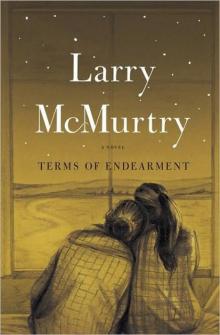 Terms of Endearment
Terms of Endearment Some Can Whistle
Some Can Whistle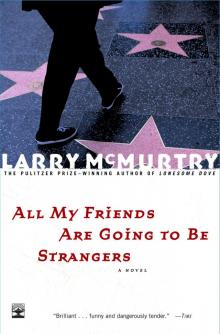 All My Friends Are Going to Be Strangers
All My Friends Are Going to Be Strangers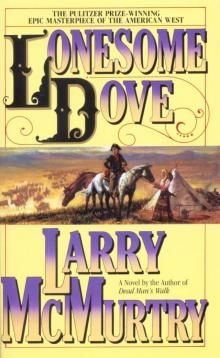 Lonesome Dove
Lonesome Dove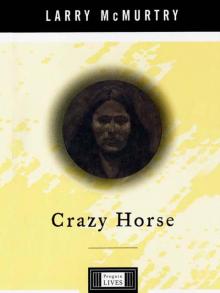 Crazy Horse: A Life
Crazy Horse: A Life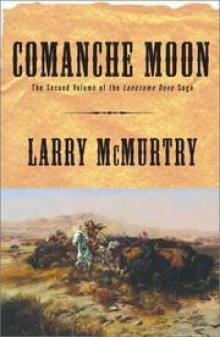 Comanche Moon
Comanche Moon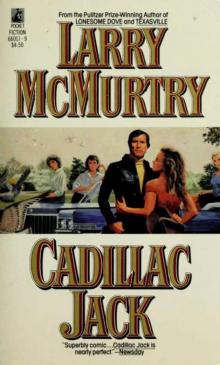 Cadillac Jack
Cadillac Jack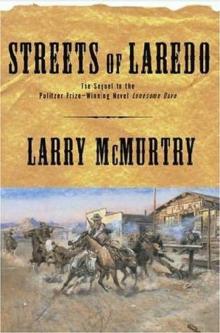 Streets of Laredo
Streets of Laredo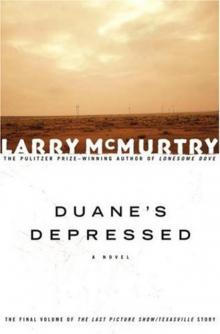 Duane's Depressed
Duane's Depressed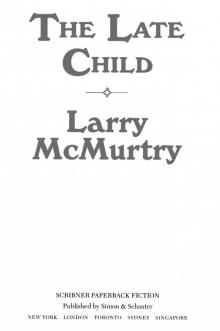 The Late Child
The Late Child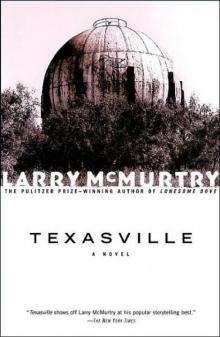 Texasville
Texasville Rhino Ranch
Rhino Ranch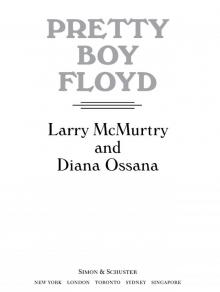 Pretty Boy Floyd
Pretty Boy Floyd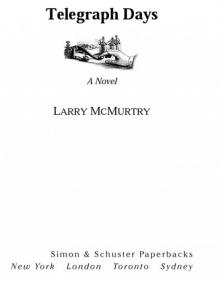 Telegraph Days
Telegraph Days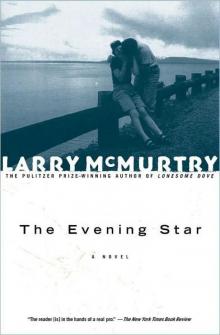 The Evening Star
The Evening Star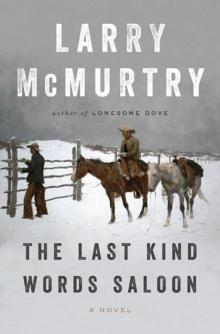 The Last Kind Words Saloon
The Last Kind Words Saloon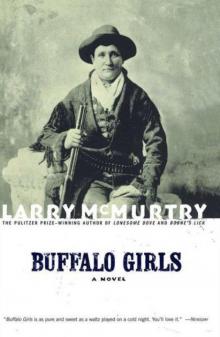 Buffalo Girls
Buffalo Girls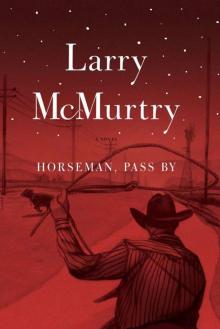 Horseman, Pass By
Horseman, Pass By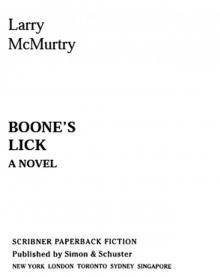 Boone's Lick
Boone's Lick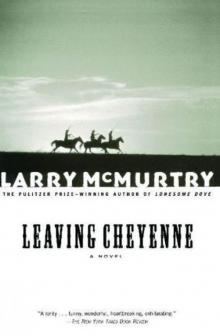 Leaving Cheyenne
Leaving Cheyenne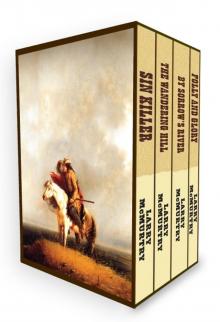 Sin Killer
Sin Killer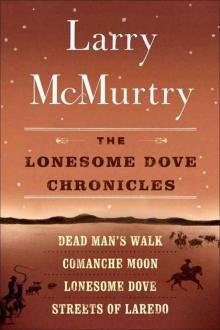 The Lonesome Dove Chronicles (1-4)
The Lonesome Dove Chronicles (1-4)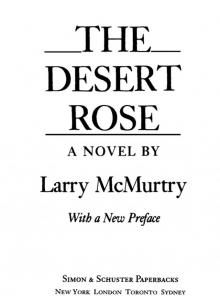 The Desert Rose
The Desert Rose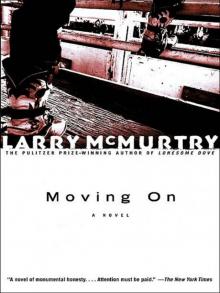 Moving On
Moving On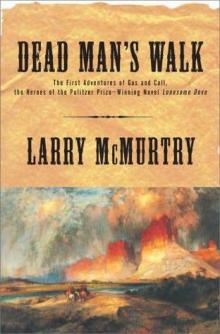 Dead Man's Walk
Dead Man's Walk The Last Picture Show
The Last Picture Show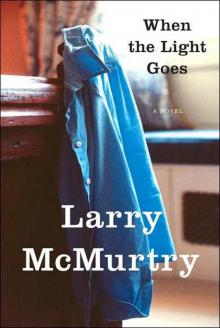 When the Light Goes
When the Light Goes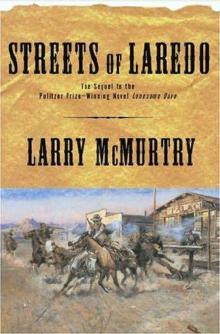 Streets Of Laredo ld-2
Streets Of Laredo ld-2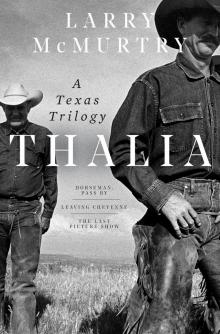 Thalia
Thalia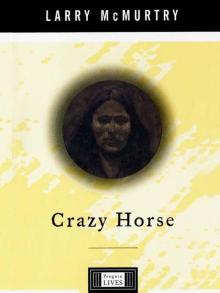 Crazy Horse
Crazy Horse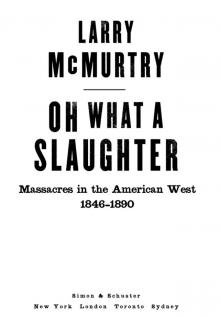 Oh What a Slaughter
Oh What a Slaughter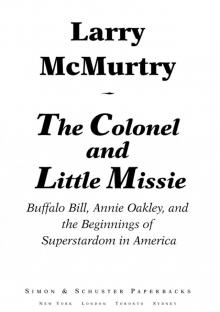 The Colonel and Little Missie
The Colonel and Little Missie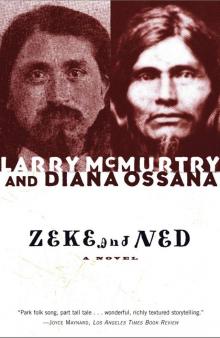 Zeke and Ned
Zeke and Ned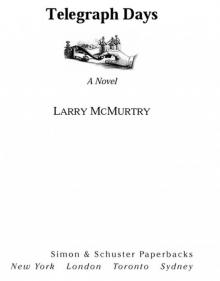 Telegraph Days: A Novel
Telegraph Days: A Novel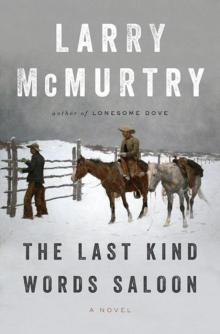 The Last Kind Words Saloon: A Novel
The Last Kind Words Saloon: A Novel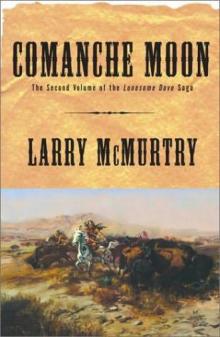 Comanche Moon ld-4
Comanche Moon ld-4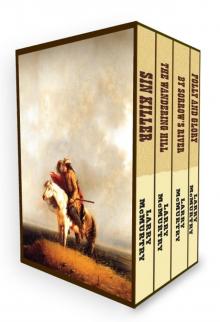 The Berrybender Narratives
The Berrybender Narratives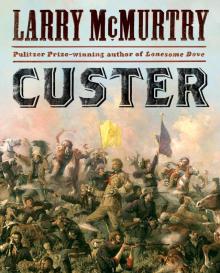 Custer
Custer